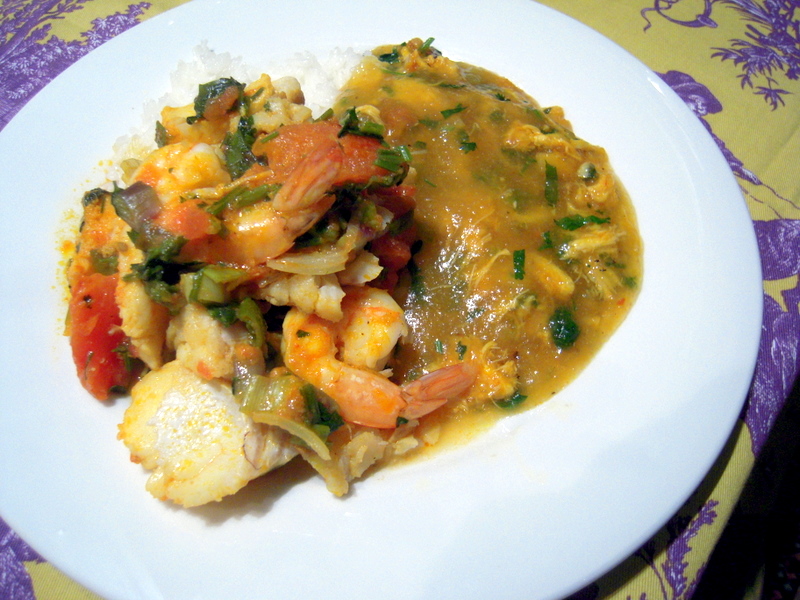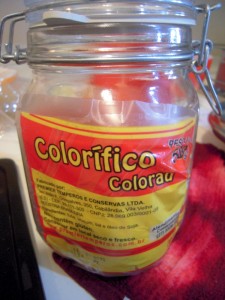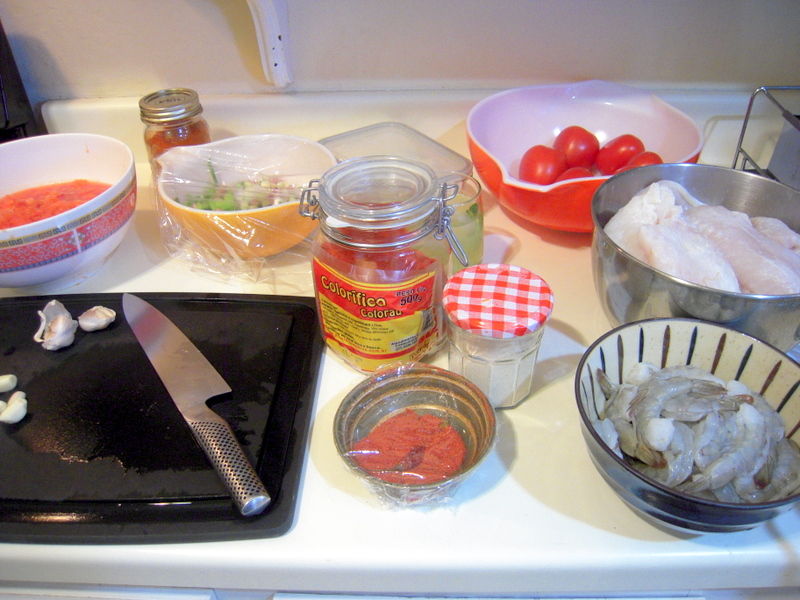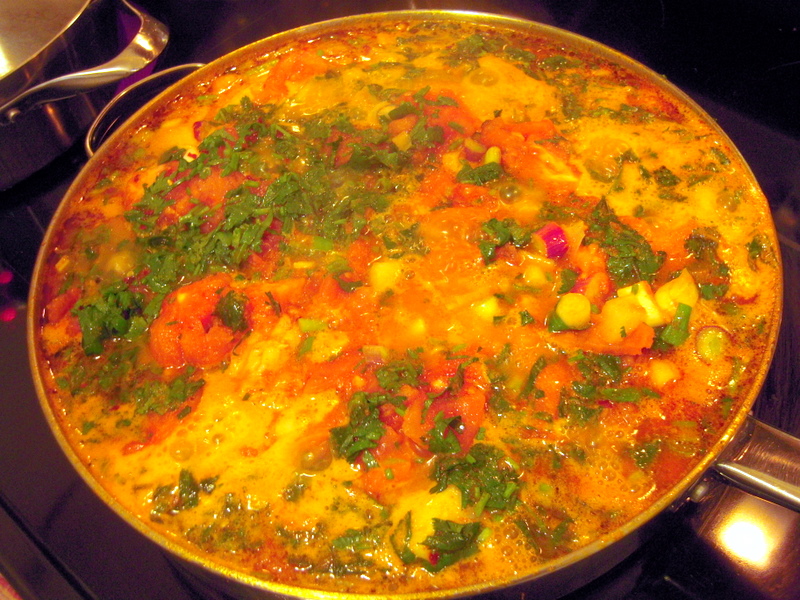I’ve already been feeling a bit homesick for Brazil, being back from my vacation there for little over a month so I decided to make moqueca capixaba, a traditional “fish stew,” to cheer myself up. It’s always popular, both here and back in Brazil.
I put the dish together for a dinner party recently with a number of friends, some of whom we hadn’t seen in a while. I wasn’t aware that we were also celebrating my belated birthday that night. Grazie mille, Fabiola, for the lovely Zabaglione cake and the almond cookies you brought from Stella Pastry in North Beach. And thank you, John, for the great spatter guard for the kitchen. I love to have new gadgets around. This tool will be particularly useful the next time I make mirchi bajji.
My actual birthday was spent flying over the Amazon forest on a 767 jet, drinking cheap red wine, and trying to sleep through as much of the ten hour flight as possible. I feel so George Clooney in Up in the Air.
Moqueca capixaba is the dish of Espírito Santo and rivals a superficially similar one from Bahia named moqueca baiana. The difference is that moqueca capixaba is lighter than moqueca baiana because coconut milk and plam oil (óleo de dendê) aren’t used. It’s prepared with urucum (similar to Mexican achiote), a powder that imparts a redish color and a tad of smokiness to the food. When you have this in Brazil, moquecas capixabas are served in beautiful, locally made clay pots. [To see an example of the pots being made, check out this earlier post at the bottom of the page.]
I made this recipe for a party of ten people, so reduce the amounts of everything if you are going to prepare it for fewer. Brazilians usually use sea bass or grouper for this dish. I used wild caught Pacific cod, which tastes great but the fish is so delicate that it falls apart with cooking. Halibut would work too.
Moqueca Capixaba
3½ lbs wild caught Pacific cod steaks
Juice of two limes
Kosher salt
Freshly ground black pepper
2 tbsp urucum powder(AKA colorau)
2 bunches chopped cilantro
2 bunches chopped scallions
1 medium onion, minced
1 lb cleaned deveined medium shrimp
½ cup olive oil
1½ lbs chopped skinless Roma tomatoes
Crushed red pepper
3 garlic cloves, minced
Rinse cod fish and pat dry. Place fish in a bowl then add salt, pepper and lime juice. Let stand for about 20 minutes.
Meanwhile peel tomatoes by cutting off the top woody part and make a cross cut at the other end. Dip them in boiling water for a minute or so until skin curls. Remove from water. Let tomatoes cool. Remove skin then chop and place in a bowl.
Using a wide deep skillet, add three tablespoons of olive oil and sauté onion and garlic until translucent. Add urucum powder (colorau) and stir for a minute or so to tint red. Stir to avoid burning or sticking.
Make a layer of tomato, scallion and cilantro at the bottom of the pan (use about half of the cilantro and scallion for this). Add cod fish in one single layer above tomatoes. Drizzle remaining fish juices over everything. Sprinkle with salt, pepper and crushed red pepper to taste. Add remaining cilantro, tomato, scallion and olive oil. Cover pan and cook for about 15 minutes in high heat. Avoid stirring to prevent fish from breaking apart. Instead shake pan a few times while cooking to gently mix. For the last minute scatter shrimp over stew and re-cover. When shrimp are done, the dish is ready.
Serve with white rice and crab pirão, made the same way as shrimp pirão by just substituting crab for shrimp.




Comments on this entry are closed.
Hi, Hegui!
Muito obrigada pelo seu comentário no De Verde Casa. Vim aqui conhecer seu blog e achei tudo muito chique! rsrsrs Fiquei lisonjeada de você ter me linkado, e em agradecimento linkei o Weird Combinations tambem.
Muito gozado é o nome “crab pirão”! Mas também, que outro jeito!? Num deve haver palavra em outra língua nenhuma que traduza pirão! A única chance é em alguma língua africana, de algum país que tenha coisa parecida na cultura alimentar… Quem sabe hora dessas suas viagens gastronômicas não vão visitar aquelas bandas?
Legais as histórias, as receitas, as fotos… parabéns!
Um beijo e manterei as visitas.
Juliana.
Oi Juliana,
Obrigado por tudo. Eu é que fico linsojeado. Volte sempre!
Adoro cozinhar e obviamente comer também. A maioria das vezes tentando ser politicamente correto(slow food, organis, eating locally grown products).
Tenho um casal de amigos naturais do Benin e eles comem comida semelhante à nossa, inclusive pirão que lá se pronuncia ‘piron’ devido a colonização Francesa após os Portugueses. Aliás foram os Portugueses quem introduziram a mandioca na dieta deles. Vou pedir uma receita do Benin and reproduzí-la aqui dentro em breve.
Abração,
H
I had seen this dish being made on Lebanese TV when our Lebanese famous chef Ramzi went to Brazil and filmed a documentary there; I have been haunted with it ever since; now I have a place to go to when I finally am ready to make it!
Would it possible to substitute Smoked Paprika for the urucum powder? This looks amazing.
Hi Mary,
You can definitely do that. Urucum has a very unique flavor. If you ever find I recommend that you give it a try.
You can also replace it with achiote (Mexican version of Urucum). You can find Achiote at Mexican stores in the US
Great info. Lucky me I discovered your website by
accident (stumbleupon). I’ve book-marked it for later!